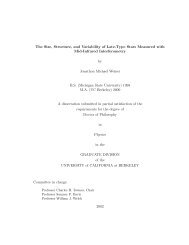Problem #1 [Structure Formation I: Radiation Era]
Problem #1 [Structure Formation I: Radiation Era]
Problem #1 [Structure Formation I: Radiation Era]
Create successful ePaper yourself
Turn your PDF publications into a flip-book with our unique Google optimized e-Paper software.
(b). At late time (y ≫ 1), compare your solutions for δ m with those derived in class.<br />
if y ≫ 1 the universe becomes matter dominated and the above expression becomes<br />
d 2 δ m<br />
dy 2<br />
+ 3 dδ m<br />
2y dy − 3<br />
2y 2 δ m = 0<br />
if we assume that this has a power solution of the form<br />
δ m ∝ y α<br />
dδ m<br />
dy = αyα−1<br />
d 2 δ m<br />
dy 2<br />
= α(α − 1)yα−2<br />
we find that<br />
which can be factored as<br />
α 2 + 1 2 α − 3 2 = 0<br />
(<br />
(α − 1) α + 3 )<br />
= 0<br />
2<br />
giving the two solutions as<br />
α = 1 α = −3/2<br />
and so we can see that<br />
δ + m ∝ y and δ− m ∝ y−3/2<br />
and we find a growing solution and a decaying solution. The two solutions from class are<br />
δ + m ∝ a δ − m ∝ a −3/2<br />
and so we know that when y ≫ 1 implies ρ m ≫ ρ r and we recover the solutions from class.<br />
(c). Verify that δ m ∝ y+2/3 is a solution to the equation in part (a) in general. Can δ m grow<br />
much in the radiation dominated era?<br />
we can verify this solution by doing<br />
δ m = y + 2 3<br />
˙ δ m = 1<br />
¨ δ m = 0<br />
and plugging this into the differential equation yields<br />
(<br />
2 + 3y<br />
2y(y + 1) − 3<br />
y + 2 )<br />
2y(y + 1) 3<br />
= 0<br />
0 = 0<br />
thus, this is a solution to the differential equation.<br />
We know that for radiation dominated era y ≪ 1 and since the solution for δ + m<br />
can see it does not grow very much during the radiation dominated regime.<br />
is linear we<br />
2


![Problem #1 [Structure Formation I: Radiation Era]](https://img.yumpu.com/37147371/2/500x640/problem-1-structure-formation-i-radiation-era.jpg)













